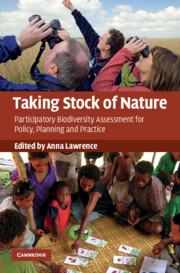Book contents
- Frontmatter
- Contents
- List of contributors
- Acknowledgements
- 1 Introduction: learning from experiences of participatory biodiversity assessment
- 2 Monitoring and assessment of biodiversity under the Convention on Biological Diversity and other international agreements
- 3 The Millennium Ecosystem Assessment: a multi-scale assessment for global stakeholders
- 4 Conservation of biological diversity in El Salvador shade coffee: the importance of taxonomic capacity for participatory assessments
- 5 Taking stock of nature in species-rich but economically poor areas: an emerging discipline of locally based monitoring
- 6 Researching local perspectives on biodiversity in tropical landscapes: lessons from ten case studies
- 7 Participatory resources monitoring in SW China: lessons after five years
- 8 Forest inventory in Nepal – technical power or social empowerment?
- 9 Perceptions of landscape change in British Columbia's Northwest: implications for biodiversity and participatory management
- 10 How thousands planned for a billion: lessons from India on decentralized, participatory planning
- 11 Inside monitoring: a comparison of bird monitoring groups in Slovenia and the United Kingdom
- 12 The personal and political of volunteers' data: towards a national biodiversity database for the UK
- 13 Improving forest management through participatory monitoring: a comparative case study of four community-based forestry organizations in the Western United States
- Index
- References
9 - Perceptions of landscape change in British Columbia's Northwest: implications for biodiversity and participatory management
Published online by Cambridge University Press: 06 December 2010
- Frontmatter
- Contents
- List of contributors
- Acknowledgements
- 1 Introduction: learning from experiences of participatory biodiversity assessment
- 2 Monitoring and assessment of biodiversity under the Convention on Biological Diversity and other international agreements
- 3 The Millennium Ecosystem Assessment: a multi-scale assessment for global stakeholders
- 4 Conservation of biological diversity in El Salvador shade coffee: the importance of taxonomic capacity for participatory assessments
- 5 Taking stock of nature in species-rich but economically poor areas: an emerging discipline of locally based monitoring
- 6 Researching local perspectives on biodiversity in tropical landscapes: lessons from ten case studies
- 7 Participatory resources monitoring in SW China: lessons after five years
- 8 Forest inventory in Nepal – technical power or social empowerment?
- 9 Perceptions of landscape change in British Columbia's Northwest: implications for biodiversity and participatory management
- 10 How thousands planned for a billion: lessons from India on decentralized, participatory planning
- 11 Inside monitoring: a comparison of bird monitoring groups in Slovenia and the United Kingdom
- 12 The personal and political of volunteers' data: towards a national biodiversity database for the UK
- 13 Improving forest management through participatory monitoring: a comparative case study of four community-based forestry organizations in the Western United States
- Index
- References
Summary
Introduction
Throughout British Columbia (BC), as elsewhere in North America, debates surrounding biodiversity and landscape conservation have deepened as a result of the efforts of government and non-governmental organizations to establish large protected areas and limit the activities of resource development interests (such as timber companies and mining corporations) in ecologically sensitive landscapes. Such plans ultimately attempt to restore natural ecosystems by limiting human activity within selected areas and by restoring ecological processes such as fire, flooding, and erosion. Support for these plans is often the most strident in urbanized areas where people are least affected by concerns for the loss of socio-economic well-being and cultural identity. In BC's remote forested landscapes, which have contributed significantly to the identity of First Nations1 and non-aboriginal residents alike, residents express opposition towards any conservation strategy that purports to remove humans as an agent of change in the natural landscape. Even conservationists are beginning to question whether ‘naturalistic’ approaches to landscape management conflict with the conservation of biodiversity and traditional landscapes (Hull and Robertson, 2000).
Owing in part to the reaction of local residents to nature conservation and landscape restoration strategies, the government of BC has begun to pay increasing attention to stakeholders' concerns by introducing and experimenting with innovative methods of public participation. However, they still face the challenge of working with competing values in decision-making processes.
- Type
- Chapter
- Information
- Taking Stock of NatureParticipatory Biodiversity Assessment for Policy, Planning and Practice, pp. 185 - 210Publisher: Cambridge University PressPrint publication year: 2010



